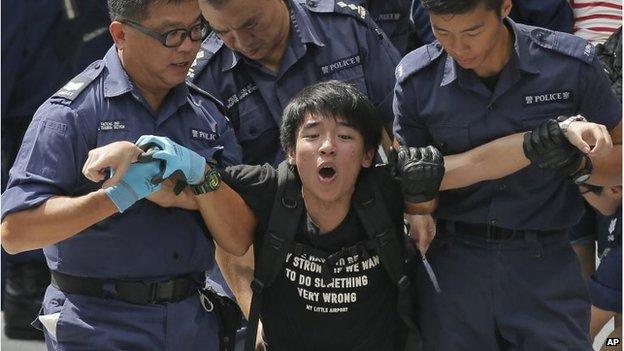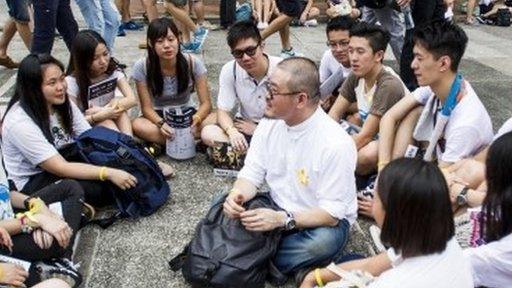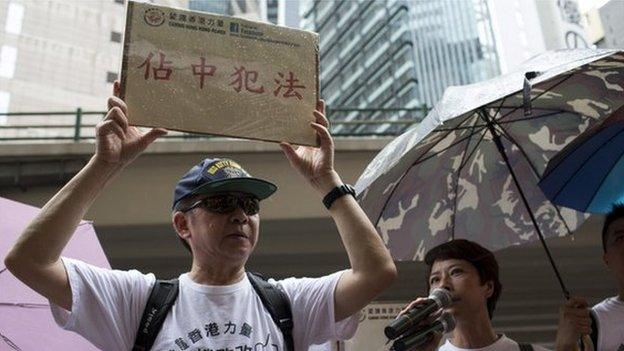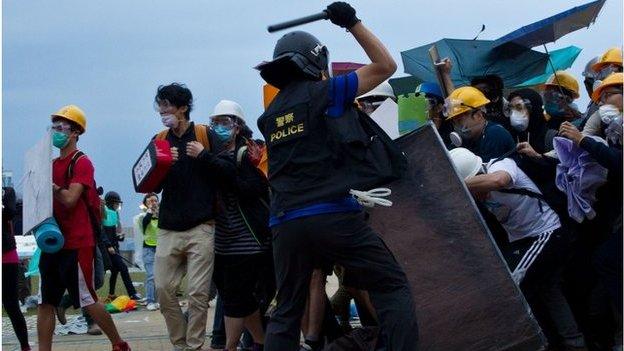Hong Kong police clear pro-democracy protesters
- Published
Juliana Liu in Hong Hong: ''Today will not be the end of the civil disobedience campaign''
Hong Kong police have cleared the main government compound of pro-democracy demonstrators who had occupied the area on Friday.
They arrested more than 60 people after a night of scuffles, with police using pepper spray to restore order. Nearly 30 people were hurt.
Reports suggest protesters remain in the area surrounding the compound.
Students and activists oppose Beijing's decision to rule out fully democratic elections in Hong Kong in 2017.
The ruling has prompted a protest movement in the autonomous territory, spearheaded by a group called Occupy Central.
In statement issued on Saturday, Occupy Central alleged that pepper spray was used without warning, and condemned the use of "unnecessary force" against "peaceful protesters".
"We strongly condemn such action which not only violates the police code of conduct but also tramples on people's freedom of expression," the group said.
Student leader held

The final few dozen protesters were hemmed in by police before being removed
The last of the protesters within the compound were removed on Saturday without resisting arrest, the South China Morning Post reported., external
The students chanted the slogan: "No fear for civil disobedience" as they were led away, the Hong Kong-based newspaper said.
The break-in occurred just before 22:30 local time on Friday (15:30 BST), as protesters scaled security fences to get inside.

Protesters were removed by police and did not actively resist arrest
The protesters smashed barriers and scaled fences to occupy a forecourt outside government headquarters.
But police managed to restore a cordon around the building's forecourt by late on Friday night before removing the final 50 on Saturday.
Police said they had arrested 61 people on suspicion of forcible entry into government premises and unlawful assembly.
A 27-year-old man was also arrested for possession of an offensive weapon.
The South China Morning Post describes the forecourt as a popular protest spot, to which access has been restricted since July.
School and university students have joined the protests in recent days, and one prominent student activist leader, Joshua Wong, was among those arrested on Friday night.
Mr Wong, 17, was dragged away in handcuffs, a student leader from Hong Kong University said.
On Thursday, about 2,000 university students held a night-time protest at the house of the Hong Kong leader, Chief Executive CY Leung.
The students' boycott is seen as a prelude to a larger demonstration planned for 1 October, organised Occupy Central, which has vowed to block the financial district.
Hong Kong operates under a "one country, two systems" arrangement with Beijing, which means citizens are allowed the right to protest.
In August, Beijing decided that candidates for the 2017 chief executive election would first have to be approved by a nominating committee. Activists have argued that this does not amount to true democracy.

Hong Kong democracy timeline
1984: Britain and China sign an agreement where Hong Kong is guaranteed "a high degree of autonomy, except in foreign and defence affairs" for 50 years following the handover in 1997.
2004: China rules that its approval must be sought for changes to Hong Kong's election laws.
2008: China says it will consider allowing direct elections by 2017.
June-July 2014: Pro-democracy activists hold an unofficial referendum on political reform and a large rally. This is followed by protests by pro-Beijing activists.
31 August 2014: China says it will allow direct elections in 2017, but voters will only be able to choose from a list of pre-approved candidates. Activists stage protests.
22 September 2014: Student groups launch a week-long boycott of classes in protest.

- Published24 September 2014
- Published22 September 2014

- Published18 June 2015

- Published23 September 2014

- Published3 December 2014

- Published20 October 2014
